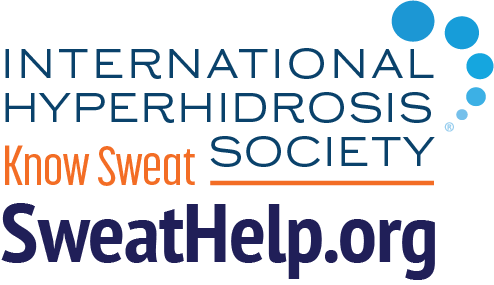Guest Blog: Discover the ABCs of Hyperhidrosis Diagnosis & Honor Hyperhidrosis Awareness Month
November is Hyperhidrosis (Hh) Awareness Month and the International Hyperhidrosis Society wants to help make sure that PAs have quick access to the information they need to make a difference in the lives of excessive sweating sufferers.
With more than 365 million people worldwide experiencing excessive sweating (4.8% of the population and 8.8% of people aged 18-39 years), hyperhidrosis is more common than psoriasis and peanut allergies. It’s also associated with a 300% greater risk of skin infections. Yet, it remains under-diagnosed and under-served. Indeed, studies show 27% of hyperhidrosis sufferers are never diagnosed.
This is unfortunate because it means that patients are not receiving the wide range of impactful treatments available to help them — effective treatments that are known to help hyperhidrosis sufferers to achieve improved daily functioning and to experience significant improvements in well-being. Also of concern is the fact that, among patients who do receive treatment, too often they are recommended modalities that prove unsatisfactory. Indeed, research has exposed a disconnect between frequently-prescribed treatments and actual patient satisfaction, indicating, for example, that Hh patients are most satisfied with botulinum toxin injections for their excessive sweating and least satisfied with antiperspirants. Yet, antiperspirants are among the most commonly prescribed treatments and injections frequently remain challenging to access. Similarly important, from a holistic point of view, clinicians can better care for the “whole” hyperhidrosis patient by recognizing the documented association between excessive sweating and mental health, with anxiety and depression being significantly more common among those with Hh than those without Hh (21.3% vs 7.5% and 27.2% vs 9.7%, respectively).
The treatment journey starts with timely and appropriate diagnosis from informed clinicians, like you. A thorough workup is initially required to rule-out secondary Hh (excessive sweating that is caused by another medical condition such as cancer, diabetes or menopause, or is a side effect of a medication such as an antidepressant.) After that, healthcare providers can solidify diagnosis of primary Hh by considering the following:
A: Age of onsetHh usually begins during childhood or adolescence (with facial sweating onset trending later).
B: BilateralHh sufferers typically experience bilateral (on both sides of the body), symmetric involvement of palms, feet, face/scalp and/or underarms (or other specific body areas or body area combinations). Bilateral means, for example, that both feet, both hands, both underarms and/or both sides of the face experience extreme sweating at the same time.
C: Cessation during sleepPeople with primary Hh usually do not sweat excessively during sleep
D: DurationTo be considered Hh, disruptive, extreme sweating episodes typically need to have been occurring consistently for the past few months. Often 2 or more episodes per week for the past 6+ months is an instructive timeline.
E: EpisodesExtreme, uncontrollable sweating will likely not be constant. Most sufferers will experience “episodes” of varying length/degree. These episodes are not related to the weather, to hot conditions, to exercise, or to stressful conditions.
F: Family66% of Hh sufferers indicate other family members have Hh, too.
G: Gets in the waySome level of sweating and increased sweating is to be expected in life. But Hh gets in the way of sufferers’ abilities to function, work, have fun, pursue dreams, develop relationships, and more.
As you and your Hh patient embark on the treatment journey, remember that Hh care can lend itself well to telemedicine, that patients can prepare for their appointments by visiting SweatHelp.org in advance, and that individualized approaches work best. Treatments may require adjustments and combinations to meet individual needs and when patients have access to an informed, involved and invested healthcare provider, like you, it can make all the difference.
As Dr. David Pariser, Secretary and Founding Member of the International Hyperhidrosis Society and 2009 President of the American Academy of Dermatology has said, “Dermatology professionals can improve the quality of life of patients with hyperhidrosis more than they can for patients with any other problem including psoriasis, eczema, acne, and even skin cancer. Hyperhidrosis is the #1 dermatological disease in terms of negatively affecting a person’s quality of life, but is also #1 in having the most dramatically positive impact when treated.”
Visit the IHhS’ medical professionals website for educational opportunities, treatment how-to videos, direct links to key medical literature, and much more. And, register your practice with the International Hyperhidrosis Society’s (IHhS) Clinician Finder so that patients who need care can find you and find the help they need. If you’re already registered, watch your mail because more than 550 informative Hyperhidrosis Toolkits are currently en-route to previously enrolled excessive-sweating-friendly and -aware practices. (Want to learn more or find out if a kit is already on the way to you? Email Info@SweatHelp.org.)
You can also watch the International Hyperhidrosis Society on its channels all November (and throughout the year) for practical information and ways to get involved with Hyperhidrosis Awareness Month:
- Facebook @SweatingStopsHere
- Twitter @WeKnowSweat
- Instagram @WeKnowSweat
- YouTube
- Wherever you enjoy podcasts, and
- SweatHelp.org
Highlights will include:
- Tips to help deal with inevitable stress sweat and body odor
- Re-launch of the Hyperhidrosis Clinician Finder featuring improvements to the healthcare provider database that make it easier for excessive sweating sufferers to find licensed, up-to-date hyperhidrosis medical care. (You can register your practice here.)
- Advice that can help save patients money on prescription and over-the-counter health expenses (whether they are for hyperhidrosis or another condition)
- A new episode of the Know Sweat Podcasts bringing listeners inspiration, support and an intimate look at the hyperhidrosis reality through the poetry of haiku
The International Hyperhidrosis Society acknowledges the generosity of individual donors, Brickell Biotech, Duradry and Dermira Inc. (a wholly-owned subsidiary of Eli Lilly) whose support has helped make our 2020 Hyperhidrosis Awareness Month initiatives possible.

